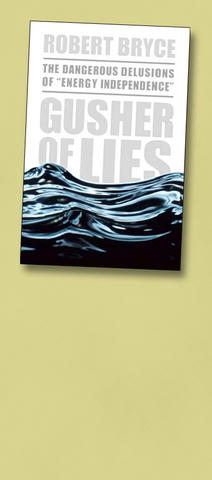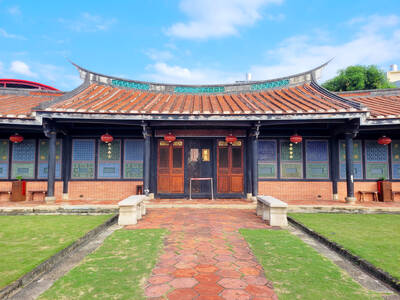After motherhood and apple pie, energy independence probably qualifies as the most popular political slogan in the US. It is, as they say, a no-brainer. Robert Bryce agrees: You have to have no brain to think it is possible or even desirable.
In Gusher of Lies, Bryce, a freelance journalist specializing in energy issues, mounts a savage attack on the concept of energy independence and the most popular technologies currently being promoted to achieve it. Ethanol? A scam. Wind power? Sheer fantasy. Solar power? Think again.
For the foreseeable future, which is to say the next 30 to 50 years, fossil fuels will reign supreme, as they have for the last century. Deal with it.

With all the gusto of a hunter clubbing baby seals, Bruce goes after one cherished green belief after another, but he is an equal-opportunity smiter. Having kicked the props from under every green technology in sight, he goes after the political right.
The current administration and its neo-conservative allies, he argues, have made energy independence part of the war on terror, a moral and tactical blunder. "Energy independence, at its root, means protectionism and isolationism, both of which are in direct opposition to America's long-term interests in the Persian Gulf and globally," he writes.
Bryce begins coolly, then heats up and eventually approaches core meltdown. In a perspective-setting opening chapter, he reviews the history and current state of energy needs in the US, whose situation is not nearly as desperate, he argues, as one might think. Yes, the US depends on foreign oil and natural gas, as it has for many decades, but only 11 percent of its oil came from the Persian Gulf in 2005. It imports 80 percent of its semiconductors and 100 percent of strategic minerals like bauxite and manganese.
Oil, Bruce argues, is simply a commodity. It also costs about the same, in real terms, as it always has. Oil producers need to sell just as badly as customers need to buy. It is undoubtedly true, as US President George W. Bush declared, that "America is addicted to oil." To which Bruce answers, So what?
Besides, he writes, "America's appetite is simply too large and the global market is too sophisticated and too integrated for the US to secede."
After clearing the ground, Bryce gets to work demolishing cherished green beliefs about alternative energy sources. Ethanol, in particular, drives him wild. Fuel derived from corn has channeled billions in subsidies to Midwestern farmers and agribusiness, he writes, despite glaring shortcomings. It is expensive to produce and requires enormous amounts of water when irrigation comes into play. It produces much less energy than gasoline while emitting more pollutants into the air.
Detroit loves ethanol because it can use it to inflate fuel-efficiency ratings on their cars artificially. The mammoth Chevy Suburban, produced as a flex-fuel vehicle capable of burning both ethanol and gasoline, magically boosted its fuel efficiency, since under federal rules only a vehicle's gasoline consumption need be factored into the equation. Ethanol, in other words, has allowed American car manufacturers to produce more gas guzzlers and contribute to increased imports of foreign oil.
The problem with corn and other alternative fuel sources boils down to cost and output. Fuel made from switch grass, another potential solution to the energy problem, costs a lot to produce, delivers a lot less energy than petroleum and would require, like corn, vast areas of farmland to meet a meaningful percentage of current energy needs.
Wind power and solar power have the added drawback of being intermittent and unpredictable. A town that relied entirely on solar or wind power would suffer constant service interruptions and wild fluctuations in output, which is why both technologies must be used in conjunction with traditional fossil-fuel generators.
Bryce lands one telling blow after another, but he favors a slashing, ad-hominem style of attack that can undercut his credibility, especially when he moves away from economics and technology and ventures into politics, an arena to which he brings no particular expertise. He employs a peculiar, almost actuarial assessment of the risk posed by terrorism, which he compares to random events like lightning strikes. This completely misses the point about the threat posed by radical Islam. Using the word "neocon" seems to be enough, for him, to discredit an argument or an opponent.
Fortunately, the book steers back to the high road at the end, when Bryce suggests that there is some light at the end of the tunnel, some of it solar-powered. Within modest limits, he argues, solar power can play a bigger role in meeting energy needs, especially with new technology that transforms infrared light into electricity. Algae look promising as a source of biodiesel.
The major environmental groups may even, eventually, see the point of nuclear power, "the only sector that has enough momentum and enough capital behind it to make a significant dent in the overall use of fossil fuels."
Bryce's pet idea, though, is something that does not exist - a superbattery capable of storing large quantities of electricity. As the magic wand to bring this "silver bullet" into existence Bryce proposes a Superbattery Prize awarded either by the Energy Department or private foundations: US$1 billion, say, for a compact, affordable system that can store multiple kilowatt-hours, and US$10 billion for a system that can store megawatt-hours. The hard-nosed Bryce reveals himself in the end as something of a visionary and perhaps even a revolutionary.

A jumbo operation is moving 20 elephants across the breadth of India to the mammoth private zoo set up by the son of Asia’s richest man, adjoining a sprawling oil refinery. The elephants have been “freed from the exploitative logging industry,” according to the Vantara Animal Rescue Centre, run by Anant Ambani, son of the billionaire head of Reliance Industries Mukesh Ambani, a close ally of Prime Minister Narendra Modi. The sheer scale of the self-declared “world’s biggest wild animal rescue center” has raised eyebrows — including more than 50 bears, 160 tigers, 200 lions, 250 leopards and 900 crocodiles, according to

They were four years old, 15 or only seven months when they were sent to Auschwitz-Birkenau, Bergen-Belsen, Buchenwald and Ravensbruck. Some were born there. Somehow they survived, began their lives again and had children, grandchildren and even great grandchildren themselves. Now in the evening of their lives, some 40 survivors of the Nazi camps tell their story as the world marks the 80th anniversary of the liberation of Auschwitz-Birkenau, the most notorious of the death camps. In 15 countries, from Israel to Poland, Russia to Argentina, Canada to South Africa, they spoke of victory over absolute evil. Some spoke publicly for the first
Due to the Lunar New Year holiday, from Sunday, Jan. 26, through Sunday, Feb. 2, there will be no Features pages. The paper returns to its usual format on Monday, Feb. 3, when Features will also be resumed. Kung Hsi Fa Tsai!

When 17-year-old Lin Shih (林石) crossed the Taiwan Strait in 1746 with a group of settlers, he could hardly have known the magnitude of wealth and influence his family would later amass on the island, or that one day tourists would be walking through the home of his descendants in central Taiwan. He might also have been surprised to see the family home located in Wufeng District (霧峰) of Taichung, as Lin initially settled further north in what is now Dali District (大里). However, after the Qing executed him for his alleged participation in the Lin Shuang-Wen Rebellion (林爽文事件), his grandsons were